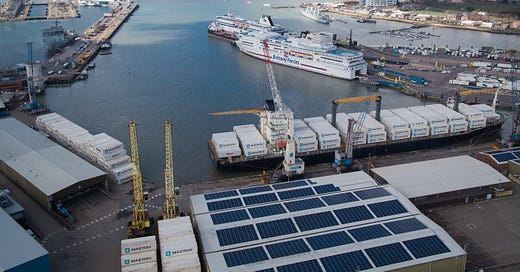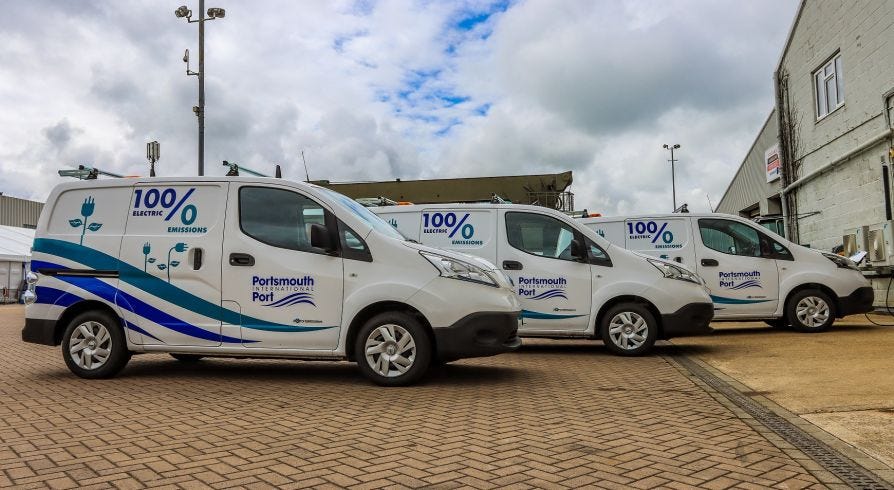Skilling up for Net Zero at Portsmouth International Port
Avoiding passing the port to the right was just the start of Portsmouth International Port’s road towards Net Zero. A Green Edge conversation.
The economic and social transformation triggered by the Paris Agreement means everyone, whether they realise it yet or not, will need to be an environmental champion in some shape or form. As the Net Zero All-Party Parliamentary Group noted in its recent report Getting to Net Zero by 2050 – or sooner:
The UK cannot lead the way to Net Zero unless it secures public support and behaviour change in the transition.
However, long before the Paris Protocol – and the term ‘Net Zero’ itself – was created, sustainability advocates and champions in business and industry have worked hard to keep the environment on the agenda of projects and the business-as-usual. Often their work has been entrepreneurial, sometimes voluntary, and always determined. The Green Edge recently had the pleasure of talking to one such individual.
The Sustainability Champion
Jerry Clarke is assistant harbour master at Portsmouth International Port. A master mariner by training, profession and licence, Jerry’s main job at the port is pilotage. But, since 1997 he has also been the port’s sustainability champion and (since 2020) senior project manager for the raft of sustainability-focused projects implemented there. He describes his day: “I'm currently in two weeks off [from the pilot roster] and I've got a 10 o'clock with you, 11 o'clock with the hydrogen project and at 14:00 with the whole City Council talking about decarbonisation. So that's a pretty average day. It is voluntary work, but probably like you guys, a lot of the reason you do this is to move it onwards”.
Portsmouth International Port is primarily a short sea port, with its main income coming through the cross-channel ferries. The port is second only to Dover for cross-channel traffic, with 3 million passengers annually at pre-Covid levels. It’s also home to Portico, which operates two multi-functional quays – Flathouse and Albert Johnson – specialising in international fresh produce, most famously bananas.
Jerry starts by describing the early days of his sustainability advocacy, finding additional funding for sustainability inclusions to the port’s capital expenditure programme. He explains: “In ‘97 we started going over to Europe. Europe had very quickly identified that Dover was a pinch point to the free movement of goods and therefore we were the next best thing”.
One of the first European-supported projects was the building of Princess Royal Way, a short spur road into the port from the main M275 feeder in to Portsmouth. Jerry describes the spur as “probably the best thing we've ever done in the port for reducing carbon”. While it only saves a relatively short turnround journey – passing the port on the right, down to the roundabout at the end of the motorway and back to the port entrance in the opposite lane – when scaled across the tens of thousands of trucks and cars that have used it since it was built, “we must be into the millions of miles [saved] since we put that road in”.
Not all projects have been so technologically straightforward, of course. Jerry describes an array of projects carried out over the years and supported with European sustainability grants, including a seawater heat transfer pump that cools the terminal in the summer and heats in the winter; Linkspan 4, a new floating link between ship and port that is larger than the one it replaced but consumes 11% less power through the fitting of soft start electric motors and other sustainability features; and the Interreg 2 Seas programme Ports Energy and Carbon Savings (PECS) project, which included the installation of air quality sensors around the ports of Portsmouth and Ostende.
The balance of power
We go on to talk about a high-profile project currently running at the port, this time under Innovate UK funding. The PESO (Port Energy Systems Optimisation) project is installing a new dual-chemistry lithium-ion / lead acid battery, manufactured by YUASA in Wales, and is integrating it with the port’s solar energy panels and canopies. PESO is a pilot project being led by Marine South East and supported by the port alongside Swanbarton (storage management software) and Energy Systems Catapult (power grid modelling). Its target is to provide green shore power to the new generations of hybrid and electric vessels that will be appearing at the port over the next few years. As Jerry explains, while the only vessel plugging in at present is Wightlink’s new hybrid vessel Victoria of Wight, PESO will start to change all that. At least one cruise liner customer – Noble Caledonia – has provided a letter of understanding saying that if the port can supply the shore power, then the Noble Caledonia vessels that use the port will be retrofitted to take it. A case of “if you build it, he will come”.
But the extent to which the PESO pilot is scaled up over the coming years will be a careful balancing act. At around £2 million per MW of new battery power, the investment is considerable. And while the new generation of liners like those being added to the Virgin Voyages fleet are likely to need upwards of 10MW of shore power, further investment by the port will need to be balanced against the risk of shipping operators doing their own thing and fitting batteries to their vessels, so not needing power from the shore. The port will naturally be watching technology trends and developments in this area closely.
Balancing the skills
We turn to Green Edge’s favourite subject. With all the green initiatives going on there that will make Portsmouth International Port one of the first net zero ports in the UK, what are the skills implications, both for existing and new workforce?
Again, we find a balancing act. Requirements for higher STEM knowledge and skills are obviously needed and are to some extent lacking right now. The port is in the process of recruiting a sustainability engineer. “What’s needed for these projects is someone with a systems engineering background, an engineering background, or an electrical technical background”, says Jerry, but qualifies this with “I don't want to say that we must just employ graduates”.
In fact, Jerry tells us, the port has never before had so many people coming “from the ground upwards”. He says: “When I first came here, if you wanted to go into management, say, you had to have a master mariner’s ticket. It's nice to have shipping knowledge, but on a port that doesn't actually go anywhere…it's not like Medicine.
“So we've started to have youngsters come in and literally they start by pulling on mooring ropes. Then they see an advantage of going up to the next level, which is berthing master. So they do the training with the berthing master, they get the skills and then they're running the mooring gangs. Then the guy who's running the mooring gang sees an option of coming up as an assistant manager.
“So what has happened now is that two of our four operational managers came up from pulling the ropes. But, like me, they don't have a technical background”.
So, a careful balance is needed between new graduate-level engineering skills on the one hand and on the other, management with deep experience of the port combined with sufficient technical upskilling to understand the implications of the new technologies. Jerry again: “I'm afraid we've had a couple of decades with this idea that any good manager can master his brief. Well sorry, if they don't have the technical background I don't believe they can”. The Green Edge agrees: we recall an influential McKinsey Global Institute report from 2011, in the early days of the big data revolution, that called out – quite correctly – the upcoming shortage of data scientists and, even more so, of managers who could ask the right questions of big data and understand how to act on the results. Jerry could be describing the net zero equivalent of how it was, ten or so years ago, with big data.
We suggest to Jerry that the balance will need to include a fair slice of upskilled technician-level skills too. He agrees: “Yes and I think the route for upskilling needs to be through electrical technicians and equivalents. And software with the electrical background as well, because we're also dealing with the hardware we’re putting in”.
Laboratorising the port
Portsmouth International Port, like many businesses, has a tricky path to net zero, both in terms of technologies and skills needs. But here’s the good news. As a municipal port owned by Portsmouth City Council, the port’s net zero goals can be closely tied to the goals of the city itself, more so at least than many other UK ports that are administered through trusts or are under private ownership. Jerry tells us about the work to install air quality sensors around the port and says: “It's our ownership model that has allowed us to do this. I don't think there's another port in the country that has full time air quality monitoring. My stakeholders are actually the people of Portsmouth, so we can do these things because Gerald [Vernon-Jackson, leader of Portsmouth City Council] asks us what we’re going to do about improving air quality and we say ‘well we can do this’.”
An interesting spinoff from this – and one to which Jerry refers more than once – is a readiness to ‘laboratorise’ the port. Referring again to the PESO project, Jerry tells us: “what's happened there is Marine Southeast and Swanbarton said, can we continue using your port as the subject port? And our answer is always, if it doesn't do damage to the port and it moves us forward with sustainability, then yes”.
This ‘laboratorisation’ extends to other local institutions, notably Portsmouth University. Earlier in the conversation, Jerry had told us about the good work done by local IoT company Barter for Things to build the software dashboards for the air quality sensors, and he adds to that a software add-on developed by a “clever lad from Portsmouth University” (Jerry’s words) that incorporates port shipping movements in the envelope surrounding the port. He goes on to tell us that since the university’s engineering faculty now concentrates on sustainable engineering, he has extended the offer for them to use the port as a classroom. He says: “Again, this is my boss [Mike Sellers, port director] saying laboratorise the port. So we said to Amit [Dr Amitava Roy, Senior Lecturer, Faculty of Technology, School of Energy & Electronic Engineering, Portsmouth University] we've got a meeting room that overlooks the hydrogen electrolyzer. Have your classes in the port.
“So we're looking at using the terminal for a lot more things”.
The Green Edge looks forward to further conversations with members of the port’s growing green skills ecosystem in the not-too-distant future.
Our thanks to Jerry Clarke for his time, and to Mike Pembleton and Jane Lamer of Shaping Portsmouth for facilitating our conversation.
Images courtesy of Portsmouth International Port.
Would you like to share your green skills knowledge on The Green Edge? If so, please drop us a line at greenedge@bluemirrorinsights.com.
Also, if you feel you’d like to sponsor us and become part of our Green Edge Advisory Group, please contact us at the same address.







